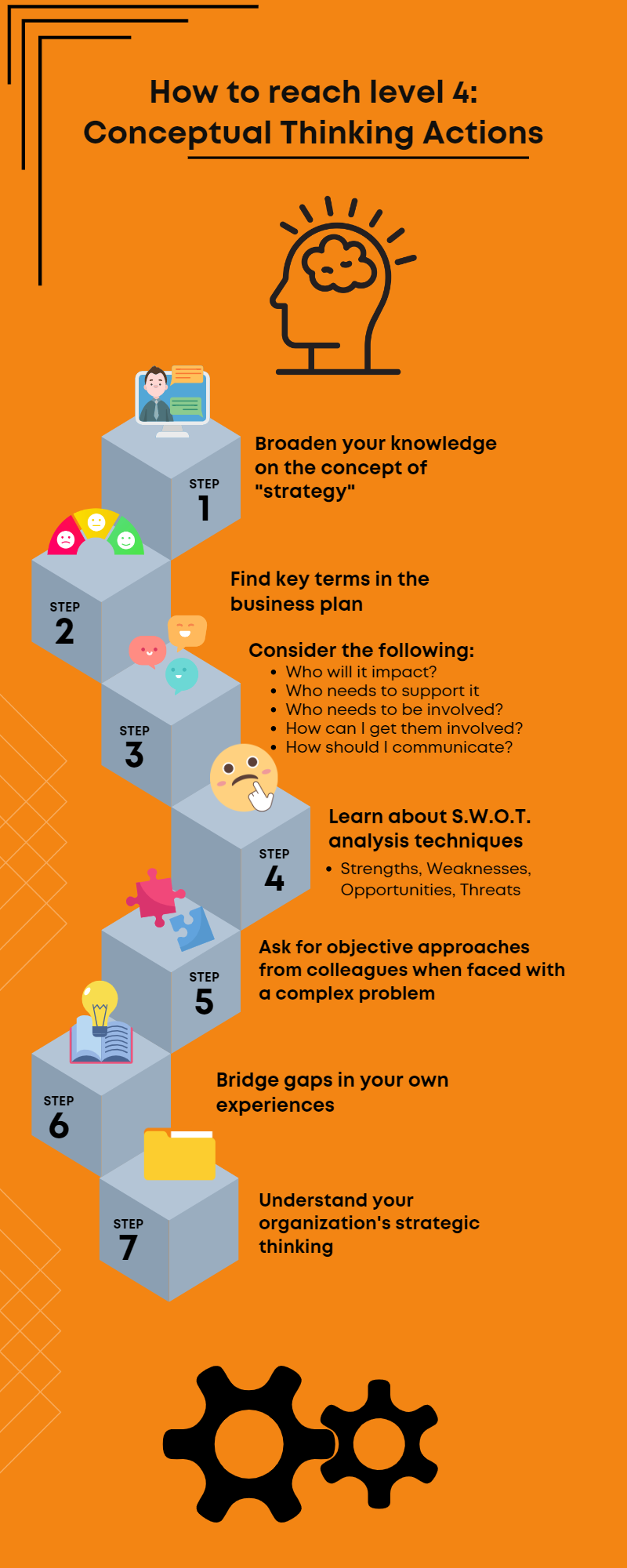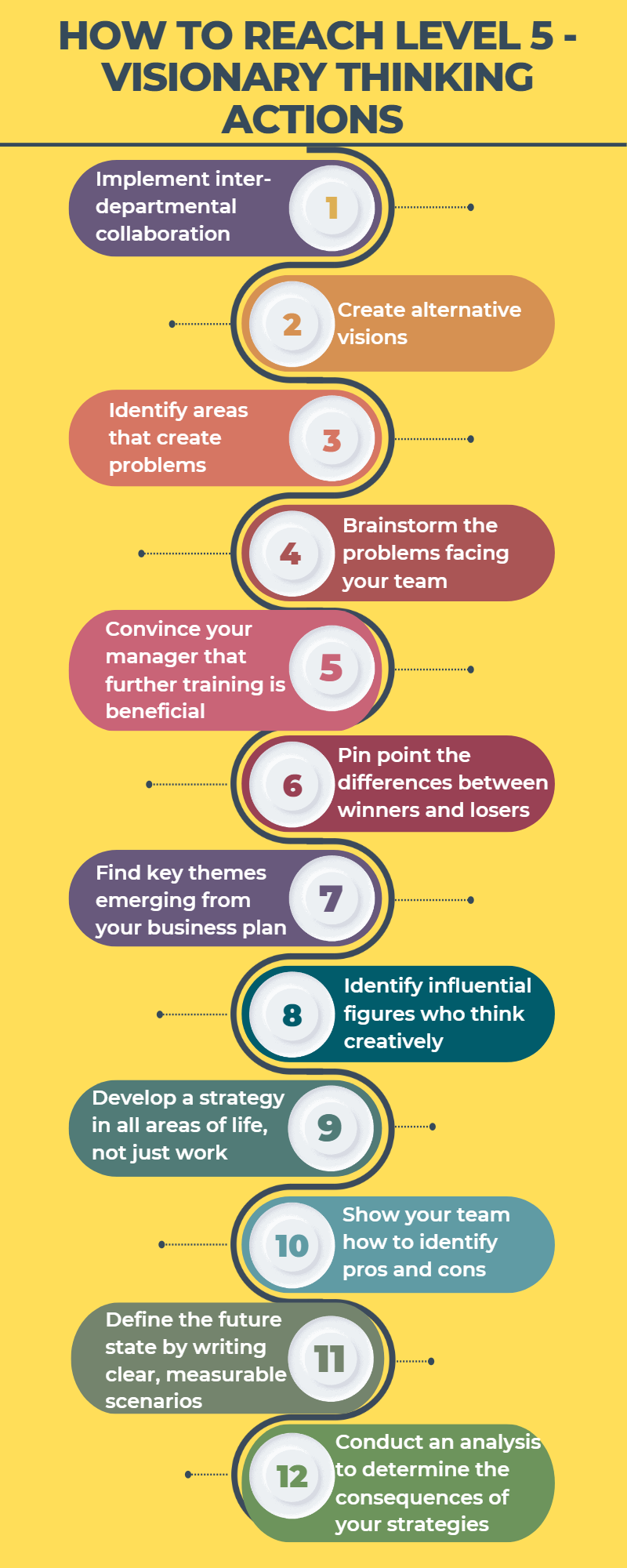The following present practical actions that leaders can take to demonstrate the levels of thinking practically.
Click here to view a video that explains the attributes of visionary leaders.
How To Reach Level 3: Diverse Perspective Actions

1. Take a problem which is taxing you but which you have "shelved". Do a "mind mapping" exercise on it to see what themes emerge.
2. Ask yourself two questions when you have a problem to solve:
- Where are we now? (Current state)
- Where do we want to be? (Desired state)
- Develop the process of how we get there before tackling a problem. (Close the gap between the current state and the desired state)
3. Use your intuition. Next time you're faced with a problem make an intuitive decision without analysing all the facts. Afterwards, check its validity.
4. Find out how business planning is undertaken in your business.
5. Get a hold of case studies on organisations. Analyse the key themes or issues in the case. Identify the factors of strategic importance.
6. Understand the long-term plans for your own department/function. Talk to your manager about the goals involved and how they will be reached. Communicate these to your team outlining the course of action the department will take.
7. Offer to write a concept paper for senior management on an issue which your belief affects the business and which is little understood. Offer alternative solutions. The next time you are considering your approach to an issue, think about the possibilities in three ways:
Little or no change → Evolutionary change → Radical change
8. Concentrate on finding the most radical answers to problems and testing them on others.
9. Try alternative ways to influence people in meetings to get momentum for change. Use diagrams and pictures as much as possible.
10. Take your team on "away days" and keep the agenda flexible. Allow them to build a picture of what they want the team to look like and how they can get there.
11. Read about right and left-brain functions. Consider the implications for work and non-work-related activities
How To Reach Level 4: Conceptual Thinking Actions

1. To gain a deeper understanding of the steps, how to start and to optimise learning during the change process, practice the following:
- Increase your understanding of the concept of "strategy". Think about where you want to be, and then work backwards.
- Read books about organisations in the process of developing or changing their strategy. Understand how the key players formulated it.
2. Find key themes emerging from the business plan that have implications for your area of work. Talk to your manager and discuss the possibility of you developing a strategy for an account or a key business function.
3. For every solution which you plan to implement consider:
- Who will this impact?
- Who needs to support this?
- Who needs to be involved?
- How can I get them involved?
- What should be my communication plan?
- Ensure that you involve people from all relevant departments early on in your planning.
4. Learn about S.W.O.T. analysis techniques (Strengths, Weaknesses, Opportunities, and Threats) or what's wrong, what's right? Apply them to the way you analyse the issues facing your team or business area.
5. When faced with a complex problem ask a colleague who is able to "step back" from situations to recommend an approach. Identify other situations that may have similar solutions. Put yourself in the shoes of an interested party and consider the problem from their viewpoint. Write down all the factors involved.
6. Identify how you can bridge gaps in your experience, where you may lack an understanding of an area. Consider secondments and being assigned to long-term projects to fill critical gaps. Get your manager's agreement to your proposed competency development and development strategy.
7. Understand your organisation's strategic thinking -the plan itself, the philosophy behind it and major policies. Read all relevant documents that express these.
How To Reach Level 5: Visionary Thinking Actions

1. Get staff to work with other units, functions or sectors to see issues from different perspectives.
2. Create alternative visions of the future and predict their impact on your unit. Spend time creating and thoroughly exploring contingency plans to cope with the unexpected.
3. For each issue you tackle, identify the areas that create the problem. Develop a strategy for dealing with them.
4. Brainstorm the problems facing your team in achieving their objectives. You can use the SWOT analysis technique to determine your main problems. Develop strategic priorities that you review at each subsequent team meeting.
5. Find out about strategic planning courses and their relevance to your job. Put a case together to convince your manager of the sound business investment that the course will offer (cost benefits and return on investment).
6. Take an interest in the strategies of organisations outside your industry. Pick out people with whom you could discuss the strategic thinking of employers. In other markets and at other stages of development. Pinpoint the differences between winners and losers.
7. Find the key themes emerging from the business plan that have implications for your area of work. Talk to your manager about you developing a strategy for an account or a key business function.
8. Identify influential figures both within and outside your company whom you see as creative and innovative thinkers. Find out how they see the business developing in the medium and long term and identify the impact their views have on your own strategies.
9. Develop a strategy for all areas of your life, not just work. See how what happens in one area affects what happens in another. Use your intuition and feelings to guide you to the solutions you want.
10. Show your staff how to develop the pros and cons of several different options. Encourage them to conceptualise the different aspects in a single framework.
11. Define the future state by writing clear, concise and measurable scenarios:
- Agree on a desired state.
- Describe in detail the conditions you will see at that midpoint. Imagine yourself in a helicopter operating a movie camera with a wide-angle lens. What does the camera see?
- Select a midpoint that can be described in specific terms.
- Write your scenario.
12. Conduct a force-field analysis for helping you to determine the consequences of your strategies. Identify the forces resisting and the forces supporting change. Ask yourself important questions such as:
- Are we focusing on all the variables?
- Do we have accurate information regarding the strength of the various forces?
- How do these forces interrelate?
- How can we get additional data?
You should then have a better idea of where you need to focus your efforts in order to move to the desired state.